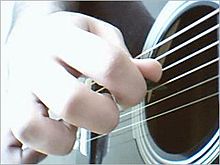The banjo is a stringed instrument with a thin membrane stretched over a frame or cavity to form a resonator. The membrane is typically circular, in modern forms usually made of plastic, originally of animal skin. Early forms of the instrument were fashioned by African Americans and had African antecedents. In the 19th century, interest in the instrument was spread across the United States and United Kingdom by traveling shows of the 19th century minstrel show fad, followed by mass-production and mail-order sales, including instruction method books. The inexpensive or home-made banjo remained part of rural folk culture, but 5-string and 4-string banjos also became popular for home parlor music entertainment, college music clubs, and early 20th century jazz bands. By the early 21st century, the banjo was most frequently associated with folk, bluegrass and country music, but was also used in some rock, pop and even hip-hop music. Among rock bands, the Eagles, Led Zeppelin, and the Grateful Dead have used the five-string banjo in some of their songs.

In music performances, rhythm guitar is a technique and role that performs a combination of two functions: to provide all or part of the rhythmic pulse in conjunction with other instruments from the rhythm section ; and to provide all or part of the harmony, i.e. the chords from a song's chord progression, where a chord is a group of notes played together. Therefore, the basic technique of rhythm guitar is to hold down a series of chords with the fretting hand while strumming or fingerpicking rhythmically with the other hand. More developed rhythm techniques include arpeggios, damping, riffs, chord solos, and complex strums.

Arthel Lane "Doc" Watson was an American guitarist, songwriter, and singer of bluegrass, folk, country, blues, and gospel music. He won seven Grammy awards as well as a Grammy Lifetime Achievement Award. His fingerpicking and flatpicking skills, as well as his knowledge of traditional American music, were highly regarded. Blind from a young age, he performed publicly both in a dance band and solo, as well as for over 15 years with his son, guitarist Merle Watson, until Merle's death in 1985 in an accident on the family farm.

A plectrum is a small flat tool used for plucking or strumming of a stringed instrument. For hand-held instruments such as guitars and mandolins, the plectrum is often called a pick and is held as a separate tool in the player's hand. In harpsichords, the plectra are attached to the jack mechanism.

Scruggs style is the most common style of playing the banjo in bluegrass music. It is a fingerpicking method, also known as three-finger style. It is named after Earl Scruggs, whose innovative approach and technical mastery of the instrument have influenced generations of bluegrass banjoists ever since he was first recorded in 1946. It contrasts with earlier styles such as minstrel, classic, or parlor style, clawhammer/frailing/two-finger style, jazz styles played with a plectrum, and more modern styles such as Keith/melodic/chromatic/arpa style and single-string/Reno style. The influence of Scruggs is so pervasive that even bluegrass players such as Bill Keith and Don Reno, who are credited with developing these latter styles, typically work out of the Scruggs style much of the time.
Lead guitar is a musical part for a guitar in which the guitarist plays melody lines, instrumental fill passages, guitar solos, and occasionally, some riffs and chords within a song structure. The lead is the featured guitar, which usually plays single-note-based lines or double-stops. In rock, heavy metal, blues, jazz, punk, fusion, some pop, and other music styles, lead guitar lines are usually supported by a second guitarist who plays rhythm guitar, which consists of accompaniment chords and riffs.

A fingerpick is a type of plectrum used most commonly for playing bluegrass style banjo music. Most fingerpicks are composed of metal or plastic. Unlike flat guitar picks, which are held between the thumb and finger and used one at a time, fingerpicks clip onto or wrap around the end of the fingers and thumb; thus one hand can pick several strings at once. Generally four are used: one for the thumb, and one each for the ring, middle and index fingers. Fingerpicks worn on the thumb are generally called "thumbpicks". Some players use a plastic thumbpick while using metal fingerpicks. Fingerpicks come in a variety of thicknesses to accommodate different musicians' styles of playing. Thin picks produce a quieter, more delicate sound, while thick picks produce a heavier sound. But as with standard plectrums, thumbpicks come in different styles and employ different materials.

Merle Robert Travis was an American country and western singer, songwriter, and guitarist born in Rosewood, Kentucky, United States. His songs' lyrics often discussed both the lives and the economic exploitation of American coal miners. Among his many well-known songs and recordings are "Sixteen Tons", "Re-Enlistment Blues", "I am a Pilgrim" and "Dark as a Dungeon". However, it is his unique guitar style, still called "Travis picking" by guitarists, as well as his interpretations of the rich musical traditions of his native Muhlenberg County, Kentucky, for which he is best known today. Travis picking is a syncopated style of guitar fingerpicking rooted in ragtime music in which alternating chords and bass notes are plucked by the thumb while melodies are simultaneously plucked by the index finger. He was inducted into the Nashville Songwriters Hall of Fame in 1970 and elected to the Country Music Hall of Fame in 1977.

Fingerstyle guitar is the technique of playing the guitar or bass guitar by plucking the strings directly with the fingertips, fingernails, or picks attached to fingers, as opposed to flatpicking. The term "fingerstyle" is something of a misnomer, since it is present in several different genres and styles of music—but mostly, because it involves a completely different technique, not just a "style" of playing, especially for the guitarist's picking/plucking hand. The term is often used synonymously with fingerpicking except in classical guitar circles, although fingerpicking can also refer to a specific tradition of folk, blues and country guitar playing in the US. The terms "fingerstyle" and "fingerpicking" are also applied to similar string instruments such as the banjo.
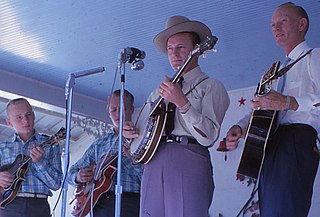
Donald Wesley Reno was an American bluegrass and country musician, best known as a pioneering banjo and guitar player who partnered with Red Smiley, and later with guitarist Bill Harrell.
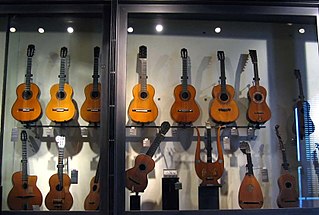
The following outline is provided as an overview of and topical guide to guitars:
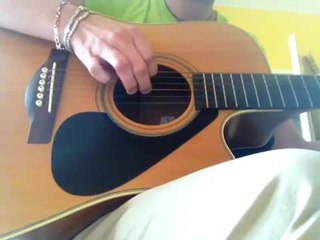
Hybrid picking is a guitar-playing technique that involves picking with a pick (plectrum) and one or more fingers alternately or simultaneously. Hybrid picking allows guitar players who use a pick to perform music which would normally require fingerstyle playing. It also facilitates wide string leaps which might otherwise be quite difficult. The technique is not widespread in most genres of guitar playing, but is most often employed in "chicken pickin'"; rockabilly, country, honky-tonk, and bluegrass flatpicking styles who play music which occasionally demands fingerstyle passages.
Hybrid picking involves playing with the pick and the right hand m and/or a fingers...at the same time. The pick is held in the usual way...and the fingers execute free strokes in the typical fingerstyle manner...Hybrid picking allows fingerstyle-like passages to be freely interspersed with flatpicked passages...without any delay.
Crosspicking is a technique for playing the mandolin or guitar using a plectrum or flatpick in a rolling, syncopated style across three strings. This style is probably best known as one element of the flatpicking style in bluegrass music, and it closely resembles a banjo roll, the main difference being that the banjo roll is fingerpicked rather than flatpicked.
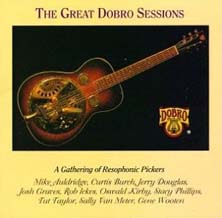
The Great Dobro Sessions is a 1994 country music and bluegrass album featuring an all-star line-up of 10 American resonator guitar players, produced by dobro players Jerry Douglas and Tut Taylor.

Russ Barenberg is an American bluegrass musician.

Carter Family picking, also known as the thumb brush, the Carter lick, the church lick, or the Carter scratch, is a style of fingerstyle guitar named after Maybelle Carter of the Carter Family. It is a distinctive style of rhythm guitar in which the melody is played on the bass strings, usually low E, A, and D while rhythm strumming continues above, on the treble strings, G, B, and high E. This often occurs during the break. The style bears similarity to the frailing style of banjo playing and is the rhythm Bill Monroe adapted for bluegrass music two decades later.

Guitar picking is a group of hand and finger techniques a guitarist uses to set guitar strings in motion to produce audible notes. These techniques involve plucking, strumming, brushing, etc. Picking can be done with:
George Shuffler was an American bluegrass guitar player and an early practitioner of the crosspicking style. During his career Shuffler played with The Bailey Brothers, The Stanley Brothers and Ralph Stanley's Clinch Mountain Boys. He was a 2007 recipient of the North Carolina Heritage Award and in 2011 was elected to the International Bluegrass Music Hall of Fame.

Roberto Dalla Vecchia is an Italian guitarist, composer, and singer. He is known for his expressive melodies and songs which include many references to traditional American music and bluegrass.
